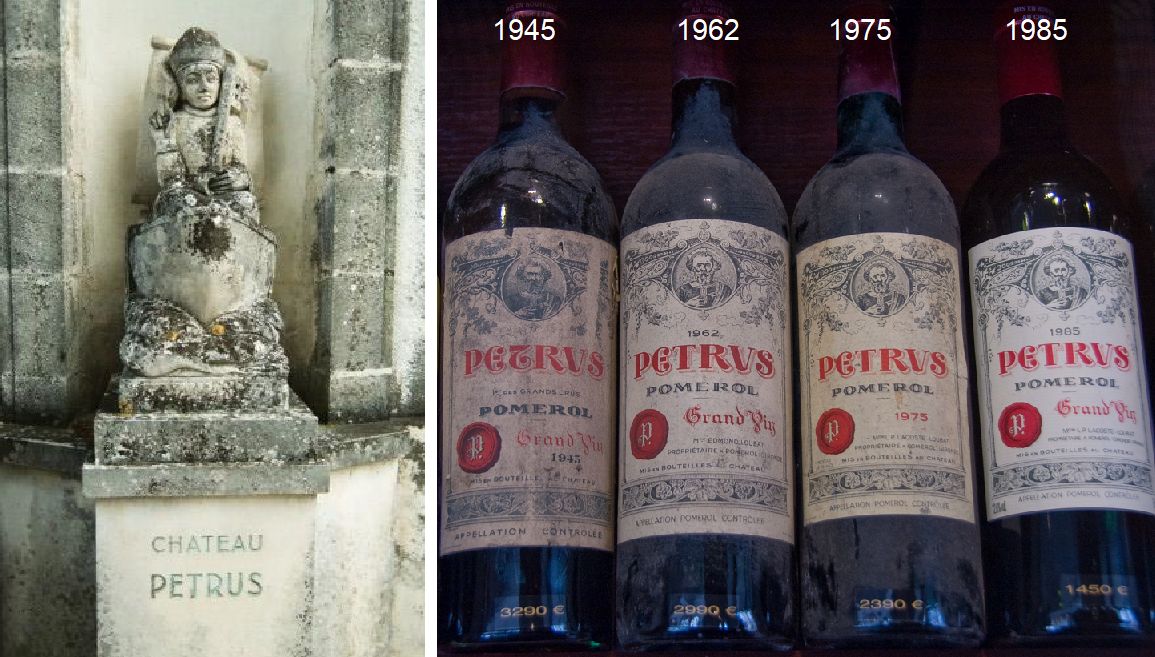The winery is located in the heart of the commune of Pomerol in the area of the same name (Bordeaux). There is a small stone statue of the eponymous apostle in the winery. Although it won a gold medal at the 1878 World Exhibition in Paris, the winery was little known internationally for a long time. This changed abruptly with the 1945 vintage, which is regarded as the wine of the century (see a bottle in the picture). In 1925, the estate was partly owned by Marie Louise Loubat (+1961) and was fully acquired by her in 1949. At that time, the vineyards covered 6.5 hectares of Merlot (70%) and Cabernet Franc (30%). In that year, Jean-Pierre Moueix (1882-1957) took over the exclusive distribution of the wine. After the death of the owner in 1961, Moueix acquired a third of the shares, the other two were inherited by Lily Lacoste (niece of Madame Loubat). In 1964, Moueix acquired a further two thirds of the shares. After the death of Jean-Pierre Moueix, his son Jean-François (*1945) took over the management in 2003 and his brother Christian (*1946) is now in charge of production.

Vineyards
The vineyards were expanded in 1969 to a total of 11.5 hectares of vines through the purchase of 5 hectares from the neighbouring Château Gazin. The grape variety was changed to 95% Merlot and 5% Cabernet Franc. The gravelly sandy-clay soil on a bed of ferruginous earth with particularly good drainage creates excellent conditions. This is ideal for Merlot, from which 100% of the wine is made in most vintages. Another criterion is the vines, some of which are up to 70 years old. And a third point is the extreme yield restriction.
During winter pr uning, only eight eyes are left on each vine (just two more would increase the yield by a quarter). In summer, a further restriction is imposed by rigorous thinning out to around half. Particular attention is paid to the grape harvest. A total of 180 harvest workers are on call. They start when the grapes have reached ideal physiological ripeness. Harvesting only begins in the afternoon so that the dew (which could dilute the must) has already evaporated. The grapes are harvested in several stages as they ripen. Unripe and unhealthy grapes are mercilessly discarded. If necessary, unusual methods are also used. Once, when it rained before the harvest began, a low-flying helicopter was used to dry the vines.
Vinification
The wine is matured for 18 to 22 months in 100% new barriques. Sensory tests are carried out on an ongoing basis and only the best barrels go into the Grand Vin. A special feature of this dark and incredibly concentrated red wine is its low acidity, which makes it soft, round and supple. Despite its high tannin content, the wine is delicate and oily, which you can literally bite and chew. It is characterised by aromas of blackcurrants, blackberries, mulberries and plums, to which tobacco notes are added over the years. It can be kept for 30, 40, 50 years or even longer. It is actually a wine that should be bequeathed to your heirs after purchase. Particularly outstanding vintages were or are 1964, 1967, 1971, 1975, 1978, 1979, 1981, 1982, 1983, 1985, 1986, 1988, 1989, 1990, 1995, 1996, 1998 and 1999.
This red wine is one of the best and most expensive wines in the world. The 2000 vintage cost between € 3,500 and € 3,800 in 2010 (the earliest it should be opened after ten years), and the well-known wine journalist Hugh Johnson commented: "Incomparable - but unfortunately only for millionaires". Pomerol does not have its own Grand Cru classification, but it is undisputedly the top wine and at least on a par with the five Premier Grand Cru Classé in the Médoc. Today, the label only says "Petrus", but on old labels "Château Pétrus" is still mentioned (by the way, there is no château = castle). Even in good years, no more than around 4,000 cases (~50,000 bottles) are produced.
Suspicion of wine counterfeiting
In the mid-1990s, the winery hit the headlines in the wine-orientated trade press regarding possible fraudulent labelling. The famous wine writer couple David Peppercorn and Serena Sutcliffe questioned the authenticity of Impériale bottles from the Château Pétrus vintages 1921, 1924, 1926, 1928 and 1934 owned by the well-known collector Hardy Rodenstock (1941-2018), which were offered for sale. The suspicion was never proven, but neither was it refuted, as the winery has no production records for these vintages.
Picture left: By Cassander the Minoan from Wikipedia, CC BY-SA 3.0, Link
Image on the right: By Frederik Vandaele - Flickr as Château Pétrus, CC BY 2.0, Link
Voices of our members

I have great respect for the scope and quality of the wein.plus encyclopaedia. It is a unique place to go for crisp, sound information on terms from the world of wine.
Dr. Edgar Müller
Dozent, Önologe und Weinbauberater, Bad Kreuznach